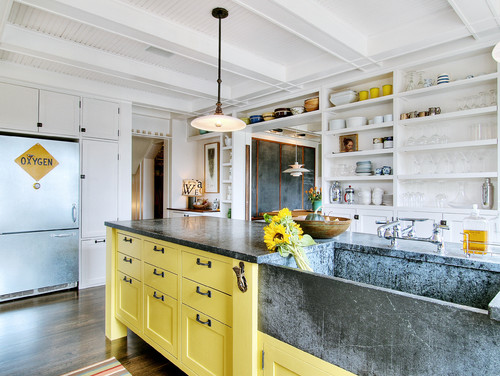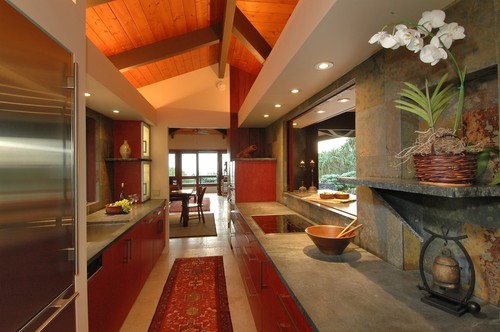The world of stone is so exciting. Not only are there hundreds of amazing granite colors (with new ones coming on the market every month) and great quartz products in every shade imaginable, but there are also versatile natural stones like soapstone, which is perfect for homeowners who want a natural material, but aren’t sure granite is right for their project.
What is Soapstone?
Soapstone is a metamorphic rock with large amounts of the mineral talc, which gives it a soft feel. That soft-to-the-touch effect is what gives this unique material its name. Soapstone is found all over the world, including the northeast of the U.S. (Virginia and Vermont, primarily), Brazil, and Finland. Humans have been putting soapstone to work in the kitchen for thousands of years. Vikings made bowls from soapstone, and early Native American civilizations used it for bowls and other objects including….wait for it…cooking slabs!
Soapstone Grows Up with America
Fast forward to the last 200 years, and soapstone is a staple of the American farmhouse. Soapstone holds heat remarkably well, and is not damaged at all by hot pots or pans. That quality made it desirable for sinks, counters, and wood burning stoves in early kitchens that needed to put up with a lot as the center of home life for hardworking farmers and craftsmen.
Today, soapstone is in high demand for other reasons as well. It is essentially non-porous, which means this extremely dense stone (30% more dense than granite and marble) is impervious to chemicals, does not stain, and is bacteria-resistant. In the last decade or so, soapstone has grown in popularity as a kitchen countertop, particularly because of its aesthetic versatility. Soft to the touch, subtle, and a powerfully understated design choice, soapstone is a wonderful addition to both the elegant rusticism of traditional home décor and the simple, clean lines of a modern or contemporary design.
How Does Soapstone Hold Up Over Time?
Soapstone is softer than granite, so over the years, you will nick and dent it. It does scratch, but these marks look more like dents than, say, a scratch on metal or granite. There are two ways to deal with marks on soapstone: by gently applying a bit of sand paper to the spot and by applying mineral oil. Because it is not porous, soapstone does not need to be sealed, but many homeowners choose to oil their counters up to once or twice a year. This hides any nicks and other marks accumulated on heavily used counters. Mineral oil also gives the stone a darker, shiner look (Note: use only 100% mineral oil created for soapstone. It’s worth it to buy a high quality product instead of using any other oil). A similar effect can be attained with special waxes like Dorado Soapstone Dry Wax.
Un-oiled, soapstone will slowly darken in color and develop a subtle patina over the years. Treating your soapstone counters with mineral oil is completely optional. It all depends on what looks best to you. In fact, many soapstone lovers list the added “character” of their counters as a benefit to choosing this timeless and trendy counter option. Of course, soapstone is not for everyone. If the idea of the counter being anything less than pristine bothers you, then granite or quartz are probably a better fit for your home.
What Colors Does It Come In?
Soapstone has a very limited color palette. Usually, it is gray, blue-gray, or green-gray. As mentioned earlier, it can be darkened with mineral oil. Some slabs of soapstone are very mono-chromatic, with little to no pattern. However, there are also deposits with large sweeping lines or striking quartz veins. Unlike granite, there is not a consistent naming system for different variations of soapstone, since it can vary so much within a single quarry. The best way to find “your” slab is to explain to your local fabricator which features of soapstone you like, and ask them to show you what is available on the market in your area.
A Few More Things to Consider When Choosing Soapstone
• While it also looks great with a bullnose edge, an eased or straight edge is usually used with soapstone to play up its strong simplicity.
• If you aren’t sure whether you are ok with the possibilities of nicks and scratches, take a big sample home and live with it for a few days.
• Soapstone is often used as a natural option for homeowners and designers who love the look of concrete in residential architecture.












